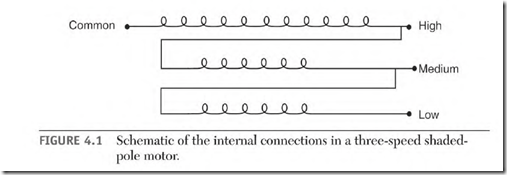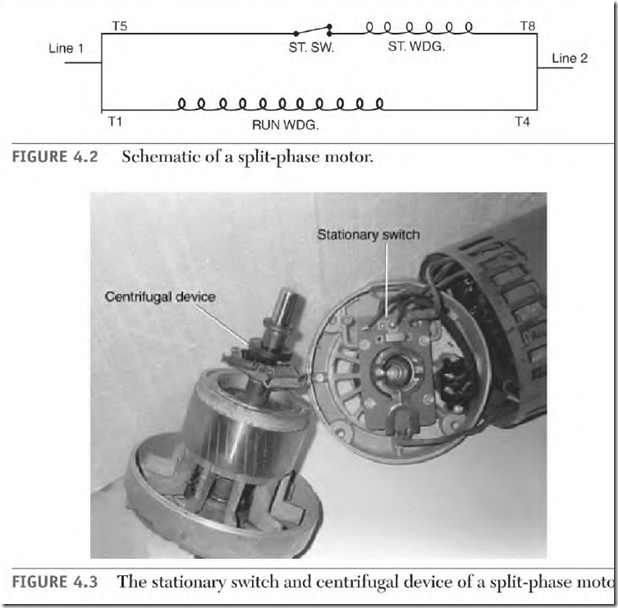Some shaded-pole motor windings have multiple taps, giving them multiple speeds (Fig. 4.1). Lower speed selections are accomplished by adding more turns or coils between line 1 and line 2. (This lowers the amperes and weakens the torque.) The rotor’s high-slip design allows the load to establish a lower speed without overheating. With no load, the motor will accelerate to near synchronous speed on all speed selections.
It is very important to connect the common lead to one side of the line (Fig. 4.1). If high and low leads are connected across the line, the windings between them will burn instantly.
Troubleshooting the Shaded-Pole Motor
The shaded-pole motor will develop worn bearings after years of use. The bearings are usually made of porous bronze that is surrounded with an oilimpregnated wicking. Oil seeping through the porous bronze lubricates the bearings. When the porous bronze becomes plugged, the bearings seize and stall the motor. In some cases, thin oil (such as WD-40) will free the bearings. The motor may run in this condition until a replacement is found. When the motor is mounted vertically or at an angle, the lower bearing fails first.
Some shaded-pole motors have a thermal cutout bulb embedded in the stator slot, next to a coil. If there is no response when the motor is energized, the thermal unit could be open and unable to reset itself. Bypass the thermal bulb by soldering its leads together. (The motor should operate satisfactorily without it.)
Split-Phase Motor
Split-phase motors are used in applications such as belt-driven furnace fans and appliances like washers and dryers. This motor has moderate to good torque. They range in size from fractional to I hp.
Components of the Split-Phase Motor
The main components of the split-phase motor are a stator, a start-winding switch assembly, and a rotor.
The stator has two windings, the run winding and the start winding (Fig 4.2). The start winding will have some type of device (switch assembly) that shuts it off after the motor starts.
The start-winding switch assembly in Fig. 4.3 has two components, a stationary switch mounted in the end frame and a
mounted on the shaft of the rotor. The stationary switch has a set of contacts that controls the start winding.
The centrifugal device holds these contacts closed when the motor is at rest.
The rotor has a low-slip design like most capacitor-start and three-phase induction motors. The squirrel cage windings are usually made of cast aluminum.
Operation of the Split-Phase Motor
Both windings are energized when the motor starts. The start winding is made with small wire. The split-phase motor is sometimes called a resistance start motor. Because of its small wire size (high-resistance winding), the start-winding coils reach peak magnetism about 1/480 second before the run winding does. This is between 40 and 50 0 separation instead of the ideal 90 ![]() (1/240 second) separation the capacitor-start motor has.
(1/240 second) separation the capacitor-start motor has.
When the split-phase motor starts, the weights on the centrifugal device pull the plastic spool away from the stationary switch contacts and shut off the start winding. The start winding is shut off at 75 to 80 percent of synchronous speed. The run winding brings the load up to nameplate RPM or above. Other start-winding control methods are discussed later in the chapter, under “Electronic Start Switch” and “Time-Delay Electronic Start Switch. ”
Troubleshooting the Split-Phase Motor
The split-phase motor components (except for the capacitor) are similar to those of the capacitor-start motor. Troubleshooting methods for the capacitorstart motor (described later) can be used on the split-phase motor. Split-phase motors are replaced rather than repaired when there is a problem.
Capacitor Motors
The types of capacitor motors are
![]() Thro-value capacitor motor (capacitor-start, capacitor-run motor)
Thro-value capacitor motor (capacitor-start, capacitor-run motor)

